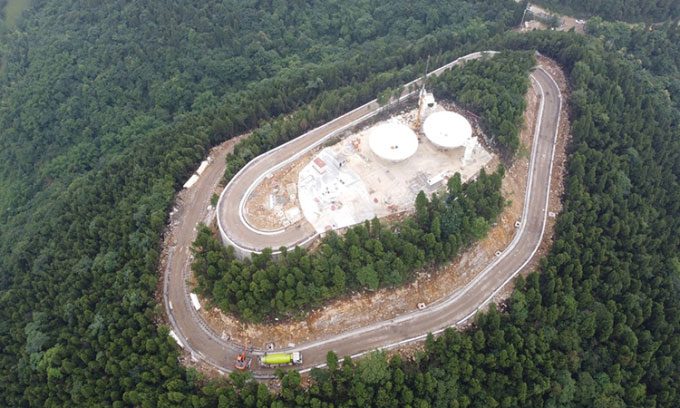A high-definition deep space radar system is being constructed in Chongqing that can observe asteroids within a range of 150 million kilometers.
The new observation facility, named Fuyan, will consist of a distributed radar network with over 20 antennas, each with a diameter ranging from 25 to 30 meters. When operating together, they will have the capability to conduct high-definition observations of asteroids within a range of 150 million kilometers, making Fuyan the world’s farthest radar system.

The deep space radar system under construction in Chongqing, southwestern China. (Photo: Chongqing Innovation Center)
The system is being developed by the Chongqing Innovation Center, in collaboration with the Beijing Institute of Technology, the National Astronomical Observatories of China under the Chinese Academy of Sciences, Tsinghua University, and Peking University. Its purpose is to enhance near-Earth defense capabilities and study asteroids.
The Fuyan program will monitor, catalog, and analyze asteroids that may pose a threat to human space activities. The radar network will also support China’s missions to explore the space between Earth and the Moon, including searching for suitable landing targets for the Tianwen-2 asteroid exploration mission.
Zhang Rongqiao, the chief designer of the Tianwen-1 Mars exploration mission, revealed to the media in May that Tianwen-2 has entered the prototype research and development phase, with a planned launch in 2025.
Tianwen-2 will be a decade-long mission, during which the probe will conduct observations, collect samples from the asteroid 2016 HO3, and return them to Earth. According to Space, this asteroid may be a fragment of the Moon.
Long Teng, president of the Beijing Institute of Technology, stated in a press release that the Fuyan program will be conducted in three phases. In the first phase, four 16-meter diameter radars will be established to verify the feasibility of the system and create 3D images of the Moon. Currently, two of these four radars have been completed and are expected to be operational by September this year.
The second phase will increase the number of antennas to over 20, forming a high-definition distributed radar network equivalent to a system with a diameter of 100 meters, allowing China to explore and photograph asteroids tens of millions of kilometers away.
The final third phase will expand the observation range to 150 million kilometers and become the world’s first deep space radar capable of creating 3D images and actively monitoring celestial bodies throughout the Solar System.
The timeline and scale of the third phase have yet to be determined, as they will depend on the results and research conducted in the previous two phases.
Unlike the operational principle of the 500-meter Aperture Spherical Telescope (FAST), which is designed to passively collect radio signals from space, Fuyan will actively transmit radio signals to celestial bodies to obtain new observations.
“This deep space radar system will certainly cover the entire range of the Earth-Moon system, as the Moon is only about 400,000 kilometers away. This means the system can monitor the trajectories of spacecraft heading to the Moon, greatly aiding China’s lunar exploration efforts,” emphasized Wang Ya’nan, editor-in-chief of the Beijing-based Aerospace Knowledge magazine, on July 10.





















































